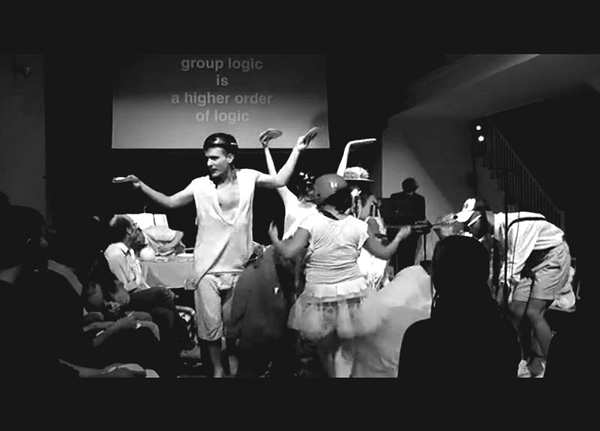
THE TRANSFORMATIONAL GRAMMAR OF THE INSTITUTIONAL GLORYBOWL: INSTITUTE_INSTITUT
first performed on
August 25, 2011
LaGuardia Performing Arts Center, Long Island City, NY
performed seven times in 2011
PANOPLY PERFORMANCE LABORATORY (PPL)
Esther Neff, Brian McCorkle
Brooklyn, NY
562787238p562787238a562787238n562787238o562787238p562787238l562787238y562787238l562787238a562787238b562787238@562787238g562787238m562787238a562787238i562787238l562787238.562787238c562787238o562787238m
panoplylab.org/institute.html
THE TRANSFORMATIONAL GRAMMAR OF THE INSTITUTIONAL GLORYBOWL: INSTITUTE_INSTITUT
PANOPLY PERFORMANCE LABORATORY (PPL)
“Insitute_Institut” was the culmination of a social-arts-practices and experimental opera trilogy called “The Transformational Grammar of the Institutional Glorybowl.” Imagining “Institute_Institut” as PPL’s last theater piece ever, we followed a three-stage plan. In the first stage, we held public “Focus Workshops” and worked to:
1.) Conceptualize and theorize an “institutionality” that would provide the greatest “benefit” to each as individuals. (This was done through open discussion, group dialogue, and videotaped interviews.)
2.) Trace and publicly describe personal relationships with institutions in the daily lives of individuals. (This was done through improvisational performance experiments and “acting” exercises.)
3.) Define the concept and word “institution.” (This was done in private, on paper, and sometimes shared with the group.)
After the Focus Workshops in Stage 2, we tried to frame the research as ways in which institutions inter-act with human ways of being. This frame allowed us connect ideas to actions and then to use performance acts (including the memorization and regurgitation of through-notated music and written text) to engage with several clusters of problematics. These clusters formed the acts of the final opera. The first act dealt with the cluster “authority to construct and disseminate “what is sensible” and the problematics of individual vs. group conception of “sense.” During this act, we attempted to stage causational, constructive, emergent, and evolutionary theories about the institution (as a verb) of sense. For example, in Act 1 of the opera, half of the performers were given blocking, costumes, and specific stereotypical personalities. The latter performers were given the general role of “animals” and improvised their movement and interactions. In Act 2, another cluster of actions and choices surrounded “homogeneity vs. diversity” problems, and in Act 3, “productive” or “nature vs. nurture” problems. Eventually, we found ourselves spiraling into self-reflexivity, entangled in “performative” problems in Acts 4 and 5, problems with “staging” and “acting” within institutions and the seepage of dramaturgical problems (“all the world’s a stage and the men and women merely players”) and their implications in terms of agency, into all parts of the public sphere. The third Stage of “Institute_Institut” was the project’s public performance as an opera. Using Arnstein’s ladder of participation, we attempted to relate to the audience through varying modes of participation. These ways included the sorting of the audience via a questionnaire at the beginning of the performance, assigning them seats (perspectives) based on their answers, and giving them a choice between two different Act 3’s.